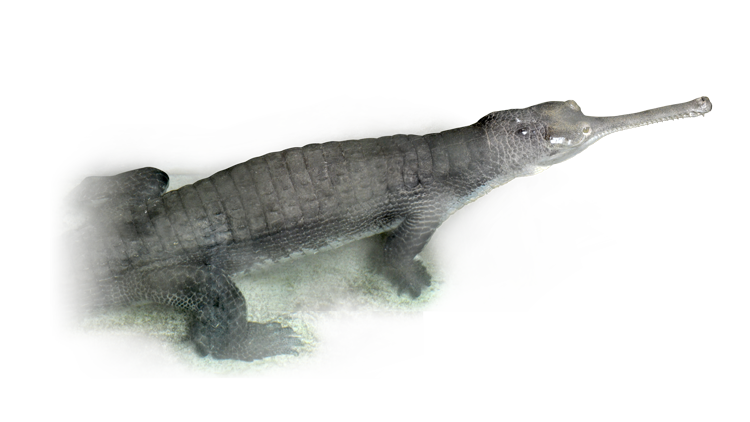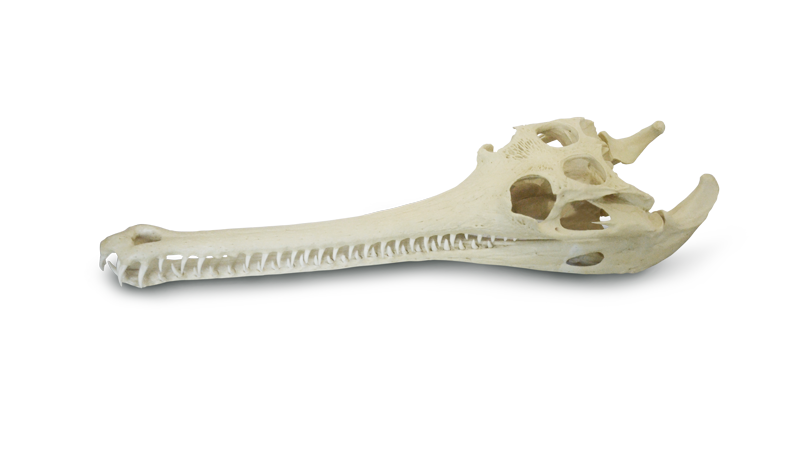
Female gharial
Gavialis gangeticus (Gmelin, 1789)
ガビエルの危機、痛風で個体数が減る
Gharial’s Crisis: Gout Reduces Population
体長はオス4 – 4.5m、メス3.5 – 4m 、平均体重は160 – 180kgにもなり、体格はイリエワニに匹敵する大型のワニです。かつてはインド亜大陸を中心にバングラディッシュ、ミャンマーに至るまで生息していましたが、2017年の調査によると300 – 900頭にまで生息数は激減しており、生息域はインドとネパールの一部の地域に限られています。
細長い吻が特徴で、顎には106 – 110本もの鋭い歯が並んでおり、鼻先を横に振り素早い動きで主食である魚を捕らえます。性的二形性を示し、鼻先が膨らんでいるのがオスです。この球根状の突起はインドの「ghara」と呼ばれる壺に似ていることが「gharial」の名前の由来です。ワニは一般的に鼻腔から「シュー」という音を出しますが、この突起は空気が鼻孔を通って押し出される際に「ブンブン」という音に変えます。これは求愛行動の際に視覚的かつ聴覚的にメスへの刺激となり、さらに交尾時には泡を発生させたりします。繁殖期は乾季の11月から2月の間が一般的です。営巣は乾季の終わりの3月から5月にかけて行い、急峻な砂洲に穴を掘り一度に28 – 60個もの卵を産み付けます。
大型のワニですが、人を襲うことほとんどありません。しかし一部の地域の人たちは恐ろしい動物だと信じており、卵を薬用に採取したり、鼻先のgharaは媚薬としての効能が信じられ、狩猟対象として迫害されています。他にも人間による環境破壊や土地開発は最大の脅威ですが、ガビアルに対する脅威は他にもあり、それは痛風による広範囲な死亡例です。2007年には、110匹のガビアルが通風が原因で死亡していますが、これは生息地であるヤムナー川にティラピアが導入され、ティラピアはガビアルに影響を与える毒素を持っていることが要因だと考えられています。実は恐竜ティラノサウルスの化石にも尿酸塩によって浸食されたと思われる跡が残っており、痛風に悩まされていたことがわかっています。古代より肉食ゆえの悩みは共通なのかもしれません。
With body lengths of 4-4.5m for males and 3.5-4m for females, and an average weight of 160-180kg, this large crocodile rivals the saltwater crocodile. It once ranged from the Indian subcontinent, extending as far as Bangladesh and Myanmar, but a 2017 survey found its population plummeting to 300-900 individuals, confining its habitat to parts of India and Nepal.
Its distinctive long snout and jaws, lined with 106-110 sharp teeth, allow it to quickly swing its snout sideways to catch its main food source, fish. It exhibits sexual dimorphism, with males possessing a bulbous snout. This bulbous protrusion resembles the Indian “ghara” pot, hence the name “gharial.” Crocodiles typically make a “whoosh” sound from their nasal passages, but this protrusion converts the air expelled through the nostrils into a “buzzing” sound. This provides visual and auditory stimulation to females during courtship displays, and they also produce bubbles during mating. The breeding season typically occurs during the dry season, from November to February. Nesting occurs at the end of the dry season, from March to May, when the male digs holes in steep sandbars and lays 28–60 eggs at a time.
Though large, gharials rarely attack humans. However, some local people consider them fearsome animals, harvesting their eggs for medicinal purposes and believing the ghara on their snouts to be an aphrodisiac, leading to their persecution. While human destruction of the environment and land development are the biggest threats, there is another threat to gharials: widespread mortality due to gout. In 2007, 110 gharials have died from gout. This is thought to be due to the introduction of Tilapia into their native Yamuna River, which contains a toxin that affects gharials. In fact, traces of uric acid erosion have been found on the fossils of the dinosaur Tyrannosaurus rex, indicating that the dinosaur suffered from gout. The worries of meat-eating may have been common since ancient times.

There are up to 58 teeth in the upper jaw and 52 in the lower jaw.
参考文献
“Gharial (Gavialis gangeticus) Fact Sheet” San Diego Zoo Wildlife Alliance Library. 2025年9月11日閲覧
“Gavialis gangeticus Gharial” Animal Diversity Web, University of Michigan Museum of Zoology. 2025年9月11日閲覧
“Gharial Crisis – An Update” WWF, (2008, March 5) 2025年9月13日閲覧
東洋経済オンライン | 痛風から感染症まで「恐竜」の最強とは程遠い実態骨から「病気」や「雌をめぐる闘いの痕跡」を発見 | (2022年8月9日) 2025年9月11日閲覧